Health History Evaluation: Analyzing Mr. C's Condition and Treatment
VerifiedAdded on 2022/10/10
|5
|1158
|350
Report
AI Summary
This report provides an evaluation of Mr. C's health history, focusing on his obesity, sleep apnea, and high blood pressure. The analysis considers the patient's lifestyle, including his sedentary job and dietary habits, as contributing factors to his condition. The report assesses the patient's risk factors for developing obesity and the appropriateness of bariatric surgery as a potential intervention. It highlights the importance of health education, particularly regarding nutritional requirements and the management of related conditions such as End-Stage Renal Disease (ESRD). The report emphasizes the need for patient-centered care and the consideration of available resources for ESRD patients, including insurance and family support, and workplace accommodations. The student's analysis concludes that bariatric surgery may be an appropriate intervention for the patient considering his conditions and health perception, while also emphasizing lifestyle changes like diet and exercise.
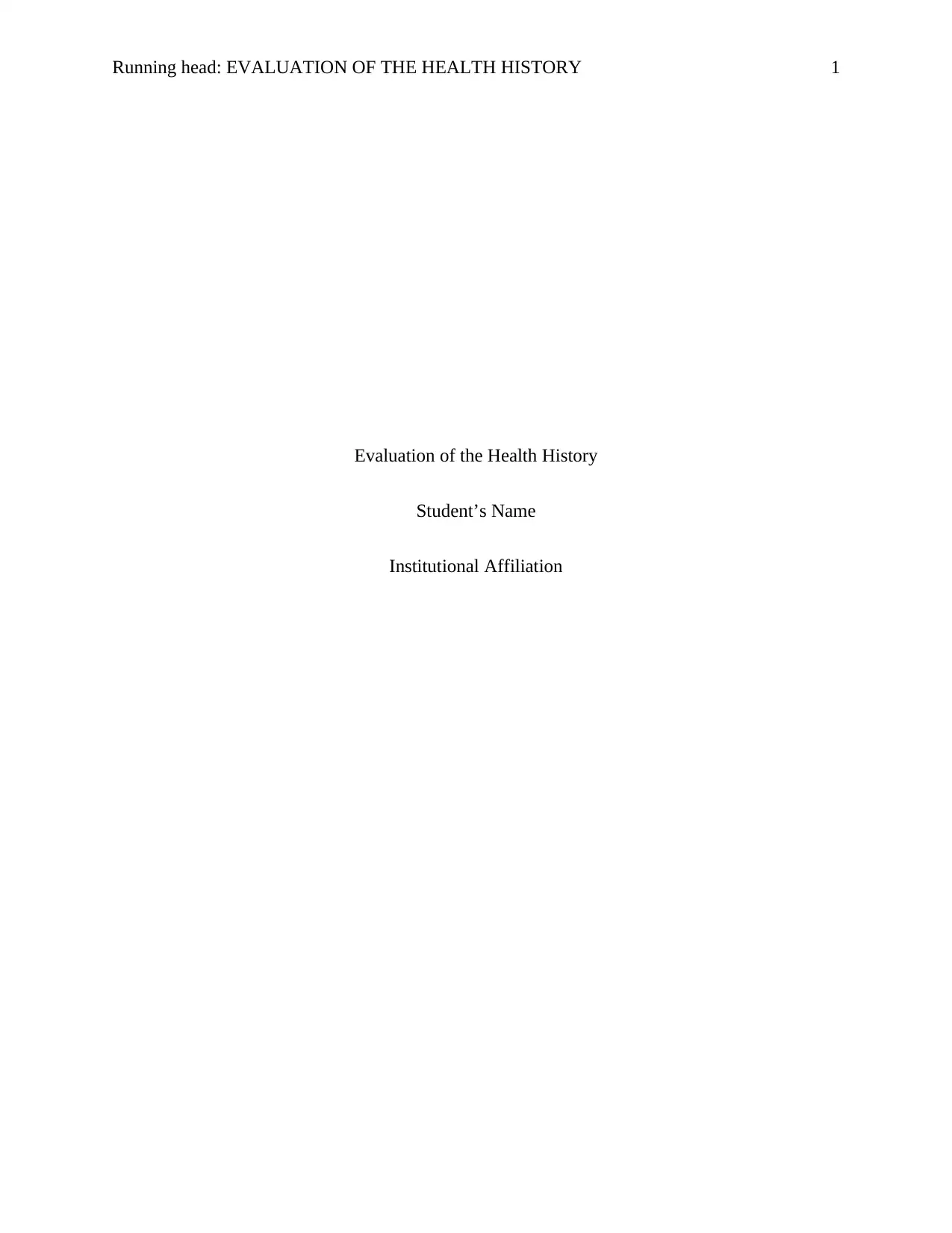
Running head: EVALUATION OF THE HEALTH HISTORY 1
Evaluation of the Health History
Student’s Name
Institutional Affiliation
Evaluation of the Health History
Student’s Name
Institutional Affiliation
Paraphrase This Document
Need a fresh take? Get an instant paraphrase of this document with our AI Paraphraser
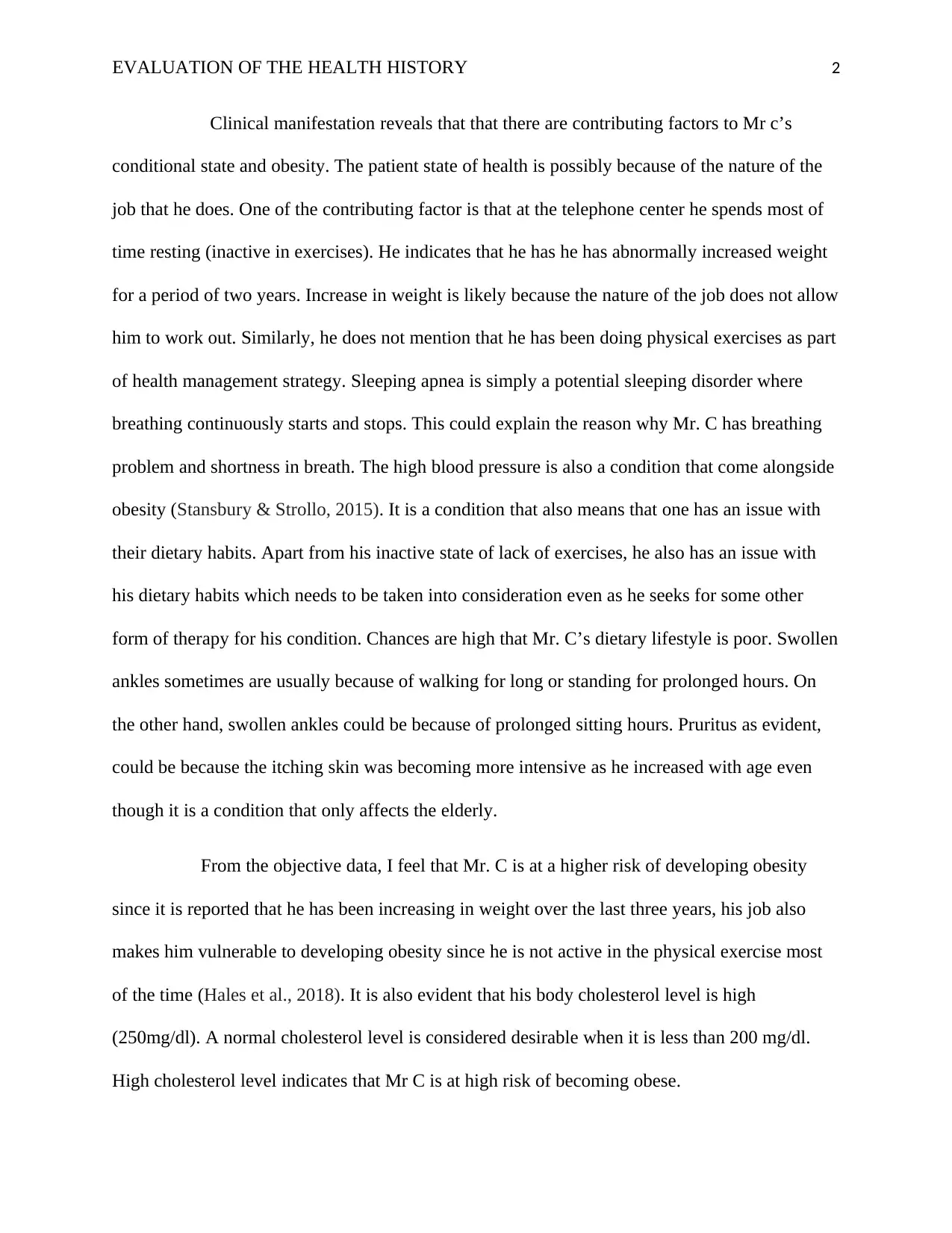
EVALUATION OF THE HEALTH HISTORY 2
Clinical manifestation reveals that that there are contributing factors to Mr c’s
conditional state and obesity. The patient state of health is possibly because of the nature of the
job that he does. One of the contributing factor is that at the telephone center he spends most of
time resting (inactive in exercises). He indicates that he has he has abnormally increased weight
for a period of two years. Increase in weight is likely because the nature of the job does not allow
him to work out. Similarly, he does not mention that he has been doing physical exercises as part
of health management strategy. Sleeping apnea is simply a potential sleeping disorder where
breathing continuously starts and stops. This could explain the reason why Mr. C has breathing
problem and shortness in breath. The high blood pressure is also a condition that come alongside
obesity (Stansbury & Strollo, 2015). It is a condition that also means that one has an issue with
their dietary habits. Apart from his inactive state of lack of exercises, he also has an issue with
his dietary habits which needs to be taken into consideration even as he seeks for some other
form of therapy for his condition. Chances are high that Mr. C’s dietary lifestyle is poor. Swollen
ankles sometimes are usually because of walking for long or standing for prolonged hours. On
the other hand, swollen ankles could be because of prolonged sitting hours. Pruritus as evident,
could be because the itching skin was becoming more intensive as he increased with age even
though it is a condition that only affects the elderly.
From the objective data, I feel that Mr. C is at a higher risk of developing obesity
since it is reported that he has been increasing in weight over the last three years, his job also
makes him vulnerable to developing obesity since he is not active in the physical exercise most
of the time (Hales et al., 2018). It is also evident that his body cholesterol level is high
(250mg/dl). A normal cholesterol level is considered desirable when it is less than 200 mg/dl.
High cholesterol level indicates that Mr C is at high risk of becoming obese.
Clinical manifestation reveals that that there are contributing factors to Mr c’s
conditional state and obesity. The patient state of health is possibly because of the nature of the
job that he does. One of the contributing factor is that at the telephone center he spends most of
time resting (inactive in exercises). He indicates that he has he has abnormally increased weight
for a period of two years. Increase in weight is likely because the nature of the job does not allow
him to work out. Similarly, he does not mention that he has been doing physical exercises as part
of health management strategy. Sleeping apnea is simply a potential sleeping disorder where
breathing continuously starts and stops. This could explain the reason why Mr. C has breathing
problem and shortness in breath. The high blood pressure is also a condition that come alongside
obesity (Stansbury & Strollo, 2015). It is a condition that also means that one has an issue with
their dietary habits. Apart from his inactive state of lack of exercises, he also has an issue with
his dietary habits which needs to be taken into consideration even as he seeks for some other
form of therapy for his condition. Chances are high that Mr. C’s dietary lifestyle is poor. Swollen
ankles sometimes are usually because of walking for long or standing for prolonged hours. On
the other hand, swollen ankles could be because of prolonged sitting hours. Pruritus as evident,
could be because the itching skin was becoming more intensive as he increased with age even
though it is a condition that only affects the elderly.
From the objective data, I feel that Mr. C is at a higher risk of developing obesity
since it is reported that he has been increasing in weight over the last three years, his job also
makes him vulnerable to developing obesity since he is not active in the physical exercise most
of the time (Hales et al., 2018). It is also evident that his body cholesterol level is high
(250mg/dl). A normal cholesterol level is considered desirable when it is less than 200 mg/dl.
High cholesterol level indicates that Mr C is at high risk of becoming obese.
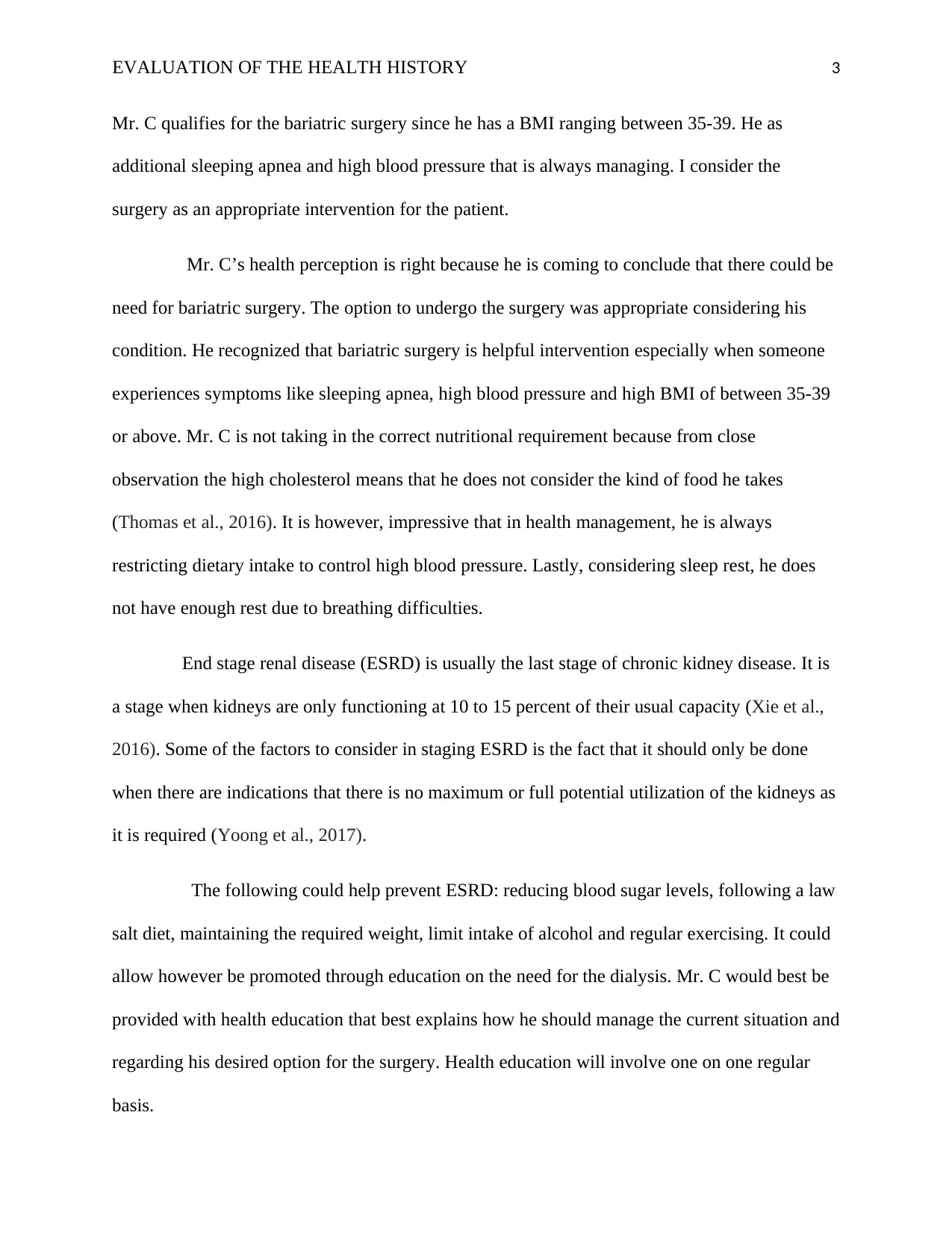
EVALUATION OF THE HEALTH HISTORY 3
Mr. C qualifies for the bariatric surgery since he has a BMI ranging between 35-39. He as
additional sleeping apnea and high blood pressure that is always managing. I consider the
surgery as an appropriate intervention for the patient.
Mr. C’s health perception is right because he is coming to conclude that there could be
need for bariatric surgery. The option to undergo the surgery was appropriate considering his
condition. He recognized that bariatric surgery is helpful intervention especially when someone
experiences symptoms like sleeping apnea, high blood pressure and high BMI of between 35-39
or above. Mr. C is not taking in the correct nutritional requirement because from close
observation the high cholesterol means that he does not consider the kind of food he takes
(Thomas et al., 2016). It is however, impressive that in health management, he is always
restricting dietary intake to control high blood pressure. Lastly, considering sleep rest, he does
not have enough rest due to breathing difficulties.
End stage renal disease (ESRD) is usually the last stage of chronic kidney disease. It is
a stage when kidneys are only functioning at 10 to 15 percent of their usual capacity (Xie et al.,
2016). Some of the factors to consider in staging ESRD is the fact that it should only be done
when there are indications that there is no maximum or full potential utilization of the kidneys as
it is required (Yoong et al., 2017).
The following could help prevent ESRD: reducing blood sugar levels, following a law
salt diet, maintaining the required weight, limit intake of alcohol and regular exercising. It could
allow however be promoted through education on the need for the dialysis. Mr. C would best be
provided with health education that best explains how he should manage the current situation and
regarding his desired option for the surgery. Health education will involve one on one regular
basis.
Mr. C qualifies for the bariatric surgery since he has a BMI ranging between 35-39. He as
additional sleeping apnea and high blood pressure that is always managing. I consider the
surgery as an appropriate intervention for the patient.
Mr. C’s health perception is right because he is coming to conclude that there could be
need for bariatric surgery. The option to undergo the surgery was appropriate considering his
condition. He recognized that bariatric surgery is helpful intervention especially when someone
experiences symptoms like sleeping apnea, high blood pressure and high BMI of between 35-39
or above. Mr. C is not taking in the correct nutritional requirement because from close
observation the high cholesterol means that he does not consider the kind of food he takes
(Thomas et al., 2016). It is however, impressive that in health management, he is always
restricting dietary intake to control high blood pressure. Lastly, considering sleep rest, he does
not have enough rest due to breathing difficulties.
End stage renal disease (ESRD) is usually the last stage of chronic kidney disease. It is
a stage when kidneys are only functioning at 10 to 15 percent of their usual capacity (Xie et al.,
2016). Some of the factors to consider in staging ESRD is the fact that it should only be done
when there are indications that there is no maximum or full potential utilization of the kidneys as
it is required (Yoong et al., 2017).
The following could help prevent ESRD: reducing blood sugar levels, following a law
salt diet, maintaining the required weight, limit intake of alcohol and regular exercising. It could
allow however be promoted through education on the need for the dialysis. Mr. C would best be
provided with health education that best explains how he should manage the current situation and
regarding his desired option for the surgery. Health education will involve one on one regular
basis.
⊘ This is a preview!⊘
Do you want full access?
Subscribe today to unlock all pages.

Trusted by 1+ million students worldwide
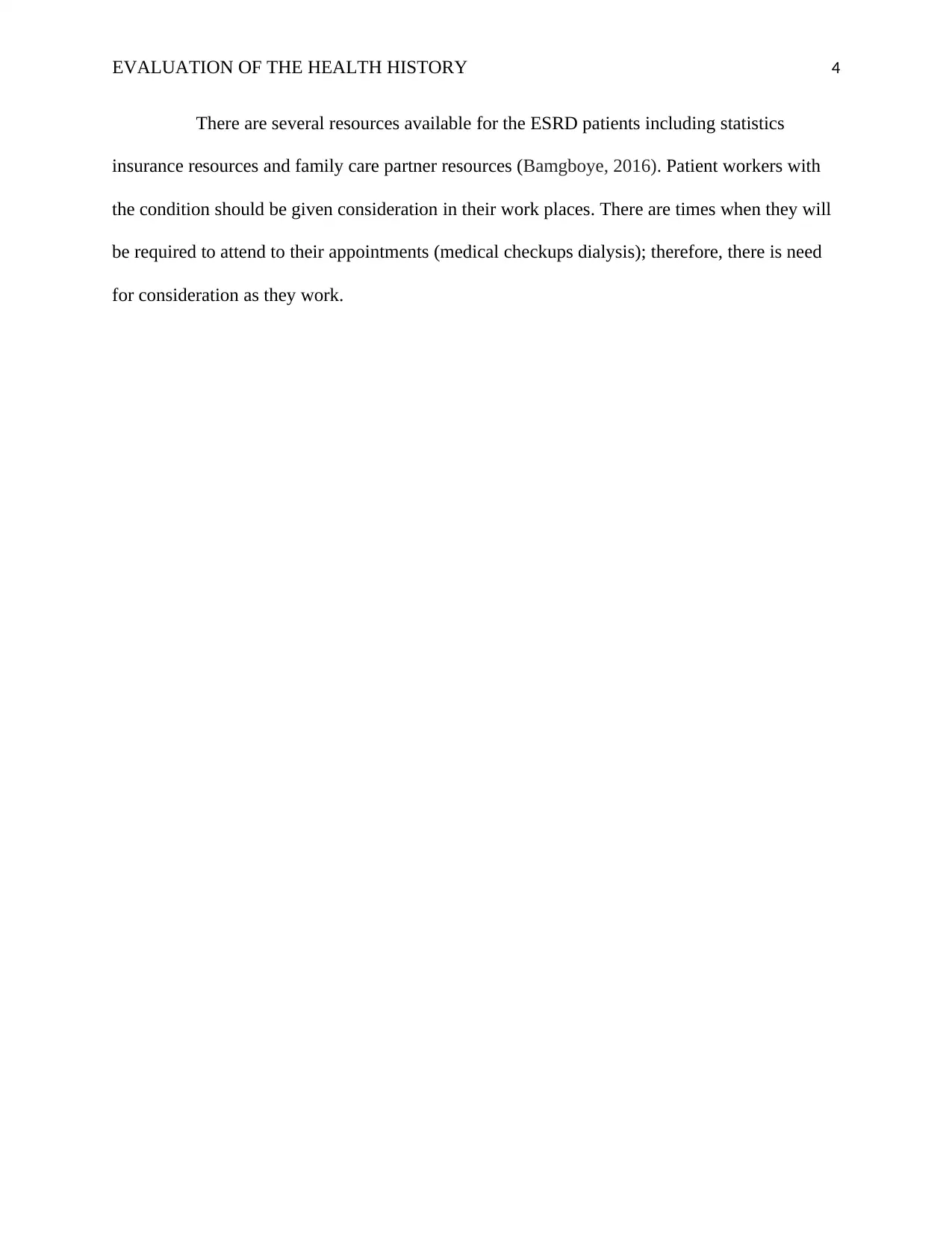
EVALUATION OF THE HEALTH HISTORY 4
There are several resources available for the ESRD patients including statistics
insurance resources and family care partner resources (Bamgboye, 2016). Patient workers with
the condition should be given consideration in their work places. There are times when they will
be required to attend to their appointments (medical checkups dialysis); therefore, there is need
for consideration as they work.
There are several resources available for the ESRD patients including statistics
insurance resources and family care partner resources (Bamgboye, 2016). Patient workers with
the condition should be given consideration in their work places. There are times when they will
be required to attend to their appointments (medical checkups dialysis); therefore, there is need
for consideration as they work.
Paraphrase This Document
Need a fresh take? Get an instant paraphrase of this document with our AI Paraphraser
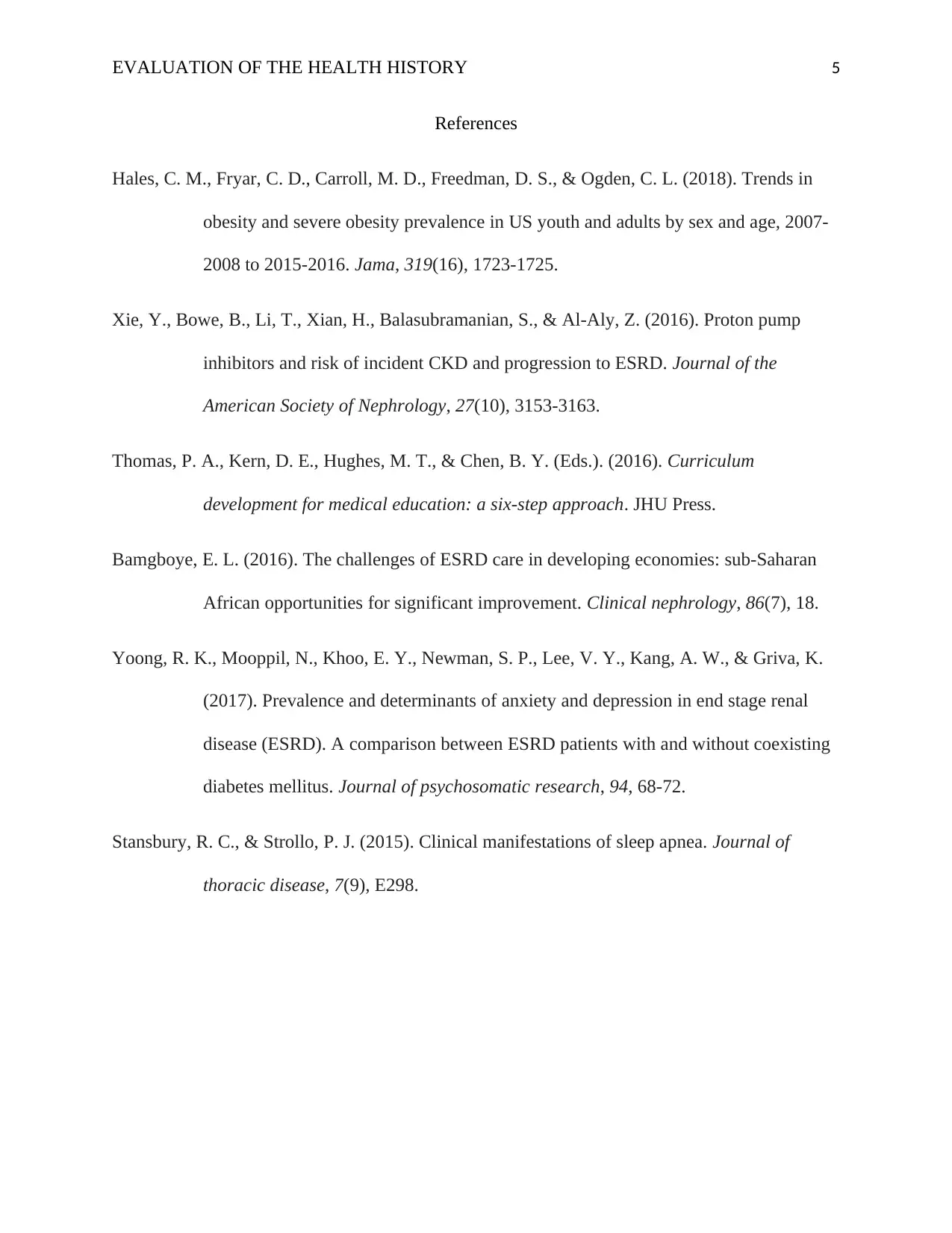
EVALUATION OF THE HEALTH HISTORY 5
References
Hales, C. M., Fryar, C. D., Carroll, M. D., Freedman, D. S., & Ogden, C. L. (2018). Trends in
obesity and severe obesity prevalence in US youth and adults by sex and age, 2007-
2008 to 2015-2016. Jama, 319(16), 1723-1725.
Xie, Y., Bowe, B., Li, T., Xian, H., Balasubramanian, S., & Al-Aly, Z. (2016). Proton pump
inhibitors and risk of incident CKD and progression to ESRD. Journal of the
American Society of Nephrology, 27(10), 3153-3163.
Thomas, P. A., Kern, D. E., Hughes, M. T., & Chen, B. Y. (Eds.). (2016). Curriculum
development for medical education: a six-step approach. JHU Press.
Bamgboye, E. L. (2016). The challenges of ESRD care in developing economies: sub-Saharan
African opportunities for significant improvement. Clinical nephrology, 86(7), 18.
Yoong, R. K., Mooppil, N., Khoo, E. Y., Newman, S. P., Lee, V. Y., Kang, A. W., & Griva, K.
(2017). Prevalence and determinants of anxiety and depression in end stage renal
disease (ESRD). A comparison between ESRD patients with and without coexisting
diabetes mellitus. Journal of psychosomatic research, 94, 68-72.
Stansbury, R. C., & Strollo, P. J. (2015). Clinical manifestations of sleep apnea. Journal of
thoracic disease, 7(9), E298.
References
Hales, C. M., Fryar, C. D., Carroll, M. D., Freedman, D. S., & Ogden, C. L. (2018). Trends in
obesity and severe obesity prevalence in US youth and adults by sex and age, 2007-
2008 to 2015-2016. Jama, 319(16), 1723-1725.
Xie, Y., Bowe, B., Li, T., Xian, H., Balasubramanian, S., & Al-Aly, Z. (2016). Proton pump
inhibitors and risk of incident CKD and progression to ESRD. Journal of the
American Society of Nephrology, 27(10), 3153-3163.
Thomas, P. A., Kern, D. E., Hughes, M. T., & Chen, B. Y. (Eds.). (2016). Curriculum
development for medical education: a six-step approach. JHU Press.
Bamgboye, E. L. (2016). The challenges of ESRD care in developing economies: sub-Saharan
African opportunities for significant improvement. Clinical nephrology, 86(7), 18.
Yoong, R. K., Mooppil, N., Khoo, E. Y., Newman, S. P., Lee, V. Y., Kang, A. W., & Griva, K.
(2017). Prevalence and determinants of anxiety and depression in end stage renal
disease (ESRD). A comparison between ESRD patients with and without coexisting
diabetes mellitus. Journal of psychosomatic research, 94, 68-72.
Stansbury, R. C., & Strollo, P. J. (2015). Clinical manifestations of sleep apnea. Journal of
thoracic disease, 7(9), E298.
1 out of 5
Related Documents
Your All-in-One AI-Powered Toolkit for Academic Success.
+13062052269
info@desklib.com
Available 24*7 on WhatsApp / Email
![[object Object]](/_next/static/media/star-bottom.7253800d.svg)
Unlock your academic potential
Copyright © 2020–2025 A2Z Services. All Rights Reserved. Developed and managed by ZUCOL.





